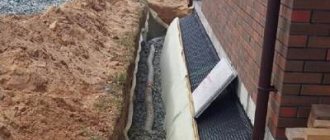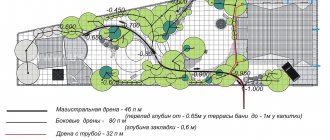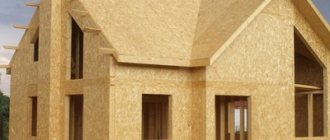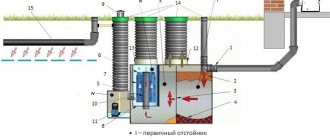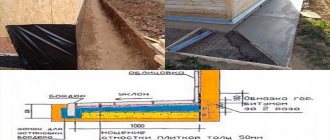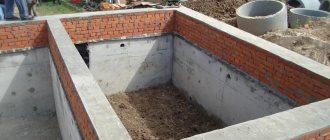Let’s make a reservation right away: drainage and waterproofing are different concepts and one of them does not exclude the other. Drainage around the house (drainage system) allows you to remove or reduce the water level in the area.
The danger lies both outside (precipitation, flood waters) and inside (groundwater). Waterproofing protects the foundation of a building from water getting inside.
But even a foundation that is well insulated from water will not protect the foundation of a private house (basement) and basement from water ingress for a long time. After all, if water presses constantly, it will find weak spots in the waterproofing. And on the contrary, if you take her away in time, your home or dacha will be safe.
DIY drainage around the house
What is drainage?
Drainage is a system that removes excess moisture from a building using a pipe structure. There is an opinion that to effectively collect water, only a blind area is enough, but experts in this field recommend installing a full-fledged drainage system, which allows for much better protection of the building from the harmful effects of moisture.
No matter how beautiful the blind area is, it will not completely protect the house from moisture Source pinterest.at
A drainage system for a home can be of three types :
- Open . It is a structure where open type trenches are used as drainage drains, the depth and width of which is 0.5 meters. This is the easiest drainage option for self-installation. The disadvantages of such a system include the unaesthetic appearance, as well as the unreliability of the structure, which will require additional reinforcement of the walls with special trays;
- Zasypnaya . This is a structure where prepared trenches are filled with coarse crushed stone or rubble, and turf is laid on top. The advantage of such drainage is its long service life and ease of installation. In addition to the advantages, there are also disadvantages: low throughput, inability to carry out maintenance;
- Closed . This is done by laying drainage pipes with holes in the ground. This system is efficient and does not have the disadvantages of other systems. Its disadvantage is that the installation is quite complicated.
A closed drainage system is difficult to do correctly without certain skills and knowledge Source handmaster.ru
See also: Contacts of companies that specialize in the installation of water supply and sewerage.
Blind area: meaning and installation
An additional element to protect the building from excess moisture is the blind area. It complements drainage. The blind area is the laying of waterproof material around the perimeter of the foundation, adjacent directly to the building.
The material should be positioned strictly at an outward angle to allow moisture to drain away. Thus, when water hits the blind area, it is immediately removed from the house. Contact of the foundation and walls with moisture will be minimal.
As a material suitable for the blind area, you can take asphalt, concrete, clay, stone, paving slabs. The first two are the most popular for blind areas and are used most often. This is due to the fact that they require less labor and capital investment. But such surfaces will not look very profitable. Paving slabs, stone and clay require more time and effort, but all work will be justified by a wonderful result and attractive appearance.
We talked about what drainage is, what types and types there are. They also gave advice on how to independently install various types of drainage. If you follow the technology, the process will go quickly and smoothly, and the result will definitely please you. Modern and high-quality drainage will protect your home from the negative effects of excess humidity, make it comfortable, and extend its service life.
Mistakes made when performing drainage yourself
Installing a drainage system without the participation of specialists is often accompanied by the following mistakes:
- The use of a wall drainage system to ensure the removal of excess moisture in areas with high groundwater levels;
- The use of pipelines in geotextile-type filters in areas with clay soil, which will ultimately lead to their clogging;
- Application of levels during pipeline laying;
- Installation of stormwater wells where drainage wells should be installed;
The most common mistake is to install only one drainage system around the house. As practice shows, this is too little. It is necessary to install a drainage system that will drain water from the roof of the building into a special well.
Also, you should avoid using one pipeline for drainage and storm water around the house, since the drainage will not cope with its functions during rains, which will lead to flooding of the area. Overmoistening of the soil near the foundation can lead to its heaving during frosts, which in turn will have a detrimental effect on the foundation of the house, even to the point of complete destruction.
Soil heaving is one of the serious reasons leading to the destruction of a house Source martand.ru
To make storm drains, orange sewer pipes (designed for soil) and special wells are used where excess water will accumulate, which can later be used to water the vegetation.
Inspection well
An inspection well is necessary to provide access to the system and carry out repair and maintenance work. The easiest way is to purchase a ready-made element: it can be found in construction stores. You can also make a well yourself. To do this you will need a wide plastic pipe. Concrete rings are also suitable for creating, or you can make a solid concrete tank. The structure must easily accommodate the human hand for repairs or cleaning. The inspection well must have a lid.
Types of drainage systems
The drainage pattern around the house is divided into two main types :
- Superficial (violates the aesthetic appearance of the site);
- Deep (perforated pipelines are used).
Surface drainage
Surface drainage around the house is more affordable, simple and easy to perform all necessary operations. Such drainages cannot cope with groundwater and are used only to drain melt and rainwater. surface drainage systems exist :
- Linear . It is used to drain rain and melt water from the entire area of the site. Through trenches dug in the soil, water is drained into a special well, where it accumulates. Such channels are closed on top with decorative grilles;
- Spot . Used to quickly collect water from one source. This drainage is covered with a special metal grate to prevent clogging. All local points are connected by pipes to the main pipeline, which drains water into the drainage well;
Carefully closed points will not disturb the inhabitants of the yard and will not spoil the exterior of the house Source evkrov.ru
- Open . It is a system of channels and drainage trays designed to drain excess water. Its unhindered movement is ensured by a bevel in the trench at an angle of about 30°, directed towards the main trench or drainage well. The advantage of an open drainage system is its low cost and ease of performing the necessary work. Disadvantages include the destructibility of the trench walls and non-aesthetic appearance;
- Closed . The arrangement is similar to open drainage, except for the use of special trays with decorative gratings, which increases the service life of the structure and also improves safety;
- Zasypnaya . This type of system is used in areas with a small area where it is not practical to install open drainage. The arrangement of backfill drainage begins with digging a channel 1 meter deep (the slope should be directed towards the drainage well). The base of the trench is covered with geotextile, after which it is filled with coarse crushed stone or gravel. To give an aesthetic appearance to the site, the structure is covered with a layer of turf on top. Such drainage of the house and site has its drawbacks, including the impossibility of maintenance during operation without dismantling work.
This is what the backfill moisture protection scheme looks like Source vse-o-kanalizacii.ru
Deep type drainage
In places with high groundwater levels, or in properties with clay soil located in lowlands, a deep drainage scheme around the house is used. Systems of this type must cope with the removal of large volumes of water, so the arrangement process is accompanied by the use of perforated pipes, the diameter of which depends on the amount of liquid being drained.
Average device price
The price depends on the volume, complexity of the soil, and the depth of the trench. A separate cost is assigned for creating a drain well:
| Type of work | Moscow and Moscow region, rub/pg.m | St. Petersburg and Leningrad Region, rub/pg.m | Krasnodar, rub/pg.m | Kazan, rub/pg.m | Rostov-on-Don, rub/sq.m |
| Deep drainage, up to 80 cm | From 1200 | 1100 | 1100 | 990 | 900 |
| Deep drainage, over 80 cm | From 2500 | 2500 | 2500 | 2500 | 2500 |
| Surface drainage | From 900 | 900 | 800 | 750 | 800 |
| Drain well | From 20000 | 20000 | 20000 | 19000 | 20000 |
The most important and useful information on the construction of blind areas is collected in this section.
The cost of installing turnkey drainage systems
Hiring specialists allows you to avoid many mistakes when arranging a drainage system. There are many companies on the market that provide drainage installation services, including project development and carrying out all the necessary work. The average cost of such services is 2300-5000 rubles per square meter and a depth of 1 to 3 meters, respectively.
Also, additional services may be offered, which are paid separately:
- Laying a pipeline for a storm sewer system. The cost of laying pipes to a shallow depth on average reaches 1,000 rubles per linear meter, and laying to a freezing depth is available at a price of about 1,800 rubles;
- The cost of manufacturing a manhole depends on the installation depth and reaches approximately 7,000-10,000 rubles for a recess of 1.5-3 meters, respectively;
When connecting pipes to a manhole, it is important to ensure that the joints are tight Source saratov.tiu.ru
- Installation of a storm drain is available at an average price of 4,000 rubles.
Important! It is better to sign contracts for the installation of turnkey drainage systems with trusted companies that provide a warranty period, which should be at least 3 years.
The price for drainage installation is cumulative and depends on the following conditions:
- Area of the site (cost calculation depends on the length of the canals);
- Complex of necessary works ;
- Slope angle (height between the top and bottom points of the trench);
- Soil type (work on wet clay soil is more expensive than work on regular soil);
- Groundwater level (deep drainage is more expensive than surface drainage).
Tools for work
Creating a drainage system with your own hands is not difficult if you know all the features of the site in advance. For work you will need:
- shovel;
- drill (if you need to create a drain well);
- level or laser level.
It is recommended to drill a well with the help of specialists. If this is not possible, you can dig it out yourself and strengthen the walls, for example, with tire covers. A level will be needed to create the correct slope.
Wall-mounted, closed design option
The first point with markings is the same as in the case of surface location. If in a country house the drainage system was not installed initially during construction, then a trench must be dug directly along the plane of the wall, 30–50 centimeters below the level of contact of the foundation with the ground.
- Places for constructing wells are dug at each corner of the building and connected by a trench.
- The walls are cleaned of soil and the waterproofing coating is restored using bitumen mastic.
- A leveling layer of sand is poured and compacted. The thickness should be at least ten centimeters.
- Geotextile material is being laid with a margin of 60 centimeters on each side.
- Crushed stone is laid to a height of 10–15 cm.
- Drains consisting of pipes are installed.
- Wells are being installed. Their upper level should protrude above the ground surface.
- Pipes are put into the wells. After this, the holes into which the pipes enter must be sealed hermetically.
- Crushed stone is poured onto the drains to a height of up to 20 centimeters.
- Cover the pipe and crushed stone with the edges of the material and secure them with tape that is not subject to rotting.
- The trench is backfilled and leveled.
It is important to control the slope angle during digging and leveling trenches; it should always be directed towards the lowest point.
Is drainage necessary if the soil is dry and absorbs water well, and the house is not prone to flooding? Here you should know that the terrain and soil composition, as a rule, do not change, but no one is immune from climate changes, for example, heavy rainfall. This is especially important in the spring, when the snow melts. Therefore, it is better to prevent possible troubles.
